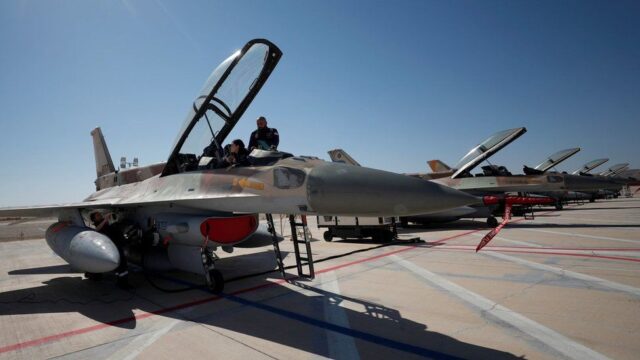According to the outgoing Israeli Defense Chief of Staff, the Jewish state is ready for an armed intervention that could be supported by the United States.
The gradual weakening of the wave of demonstrations underway in Iran since mid-September 2022 increases the likelihood of an attack led by Israel and the United States against Iran’s nuclear infrastructure, to prevent Tehran from acquiring nuclear weapons. As stated last week by the outgoing Chief of Staff of the Israeli Defense Forces (IDF), General Aviv Kohavi, the Jewish state is now ready for any intervention which will also see the support of the United States to prevent Iran from qualities of an atomic weapon. Moreover, four months after the beginning of the riots in Iran against the theocratic regime of the ayatollahs, the momentum of the protests is now increasingly weak, which distances the hypothesis of a regime change. Furthermore, the negotiations on the relaunch of a nuclear agreement between Tehran and the powers of the 5+1 group (China, France, United Kingdom, Russia, United States and Germany) have failed, with the Islamic Republic continuing unabated the development of its atomic program and which is preparing to equip itself with the powerful Su-35 multi-purpose fighters, in return for sending the notorious Shahed 136 drones to Russia used in the war in Ukraine.
Protest Supported by Intellectual
Months of continuous protests also supported by intellectuals and members of the establishment have not led to the initially desired regime change. The largest wave of protests since the Islamic Revolution of 1979 has not in fact brought the support of members of the Armed Forces, let alone the police, a fundamental factor for the success of regime change as occurred in Egypt and Tunisia during the Arab Spring of 2011. For some weeks now, the Critical Threats Project (Ctp) website – which has been monitoring the demonstrations since their explosion following the death of the 22-year-old Kurdish woman, Mahsa Amini, in Tehran last September 16 – has only recorded protests of moderate or low intensity, concentrated above all in the capital and in historically turbulent areas such as the Kurdish provinces of the north of the country and the provinces of Sistan-Baluchistan (in the east) and Khuzestan (in the west). Yesterday, the site recorded protests in just four cities – Tehran, Galikash, Bandar and Mahshar and Gachran – compared to the hundreds of demonstrations that between September and November involved all 131 Iranian provinces on a daily basis.
If this trend continues, the Iranian regime will inevitably succeed over time in crushing the wave of protests that will end in fatigue, repression, arrests, death sentences and executions. The Iranian government led by President Ebrahim Raisi and the entire apparatus of the Islamic Republic, in particular the Iranian Revolutionary Guards (the so-called pasdaran) are proving resolute in continuing on the hard line, regardless of economic and political pressure from the United States and Europe. On January 14, the Iranian authorities announced the execution by hanging of Alireza Akbari, former deputy defense minister of the reformist government of President Mohammed Kathami, arrested in 2019 and sentenced to death in late December on charges of spying for the British intelligence services. In this context, the much-desired relaunch of the nuclear deal is now a dead letter, especially after the United Kingdom also threatened to unilaterally withdraw from the agreement from the Joint Comprehensive Plan of Action (JCPOA) following Akbari’s execution , who was also a British citizen.
Failure of a Regime
The failure of a regime change that would have prompted Iran to voluntarily give up its nuclear program and the end of the diplomatic route of relaunching the Joint Comprehensive Plan of Action (technical term of the 2015 nuclear agreement), increase the chances of a military attack led by Israel with the support of the United States. This scenario became evident on January 13, when the former Chief of Staff of the Israeli Armed Forces (IDF), General Aviv Kohavi confirmed that Israel is ready for an attack against Iranian military infrastructure, stating that Tehran has enough fissile material to produce four nuclear devices: three with 20 percent enriched uranium, and the fourth with 60 percent enriched uranium.
To produce a nuclear weapon, the use of 90 percent enriched uranium is necessary, therefore the devices that could be manufactured by Iran are currently “dirty bombs” or weapons designed to disperse highly radioactive material on the target, by means of a explosion of adequate power. However, as Kohavi stated in a series of interviews with Israeli media at the end of his mandate, the gap between 20 percent and 60 percent enriched uranium can be closed “in a few weeks” by increasing the power of such devices and posing a great danger to Israel and its allies. “What is important is not to allow Iran to get a nuclear bomb, but also not to get to the point where the country can detonate a nuclear-capable device in a few weeks.”
General Kohavi stressed that the Israeli military has stepped up preparations for an all-out conflict with Tehran in the past two years, including enhanced intelligence services, increased munitions, improved operational plans and increased military training. In 2022, the IDF conducted two large-scale exercises in the event of an open conflict with Iran in cooperation with the United States. The latest was organized last November 30 and saw the simulation of a series of attacks against Iranian nuclear infrastructure conducted by the Israeli Air Force with the logistical support of US Air Force tankers. In interviews with Israeli media, Kohavi revealed that the IDF is preparing for a third large-scale exercise. “In less than a year we will have carried out three exercises with dozens of fighter planes, refueling aircraft, employing all operational units,” he added. “Furthermore, we have also established an Iran department in the IDF, headed by a major general. “All of this is illustrative of the level of readiness we are reaching,” said Kohavi.
As indicated by Kohavi, Israel is considering three possible strategies for an attack on Iran. The first step would be a pre-emptive strike against non-nuclear infrastructure, to demonstrate the enemy’s penetration capabilities into Iranian territory. The second is instead a direct attack against Iranian nuclear installations and ancillary sites to halt the progress of Iran’s nuclear program. Finally, should the situation eventually escalate into a full-blown military campaign, plans also include attacks on military sites and other infrastructure. The threat of a military attack on Iran was reiterated today by the Israeli authorities also in the ceremony for the change of leadership of the General Staff of the Armed Forces between Kohavi and General Herzi Halevi. In his speech on the occasion of his assumption of office, Halevi himself said: “We will prepare the Israel Defense Forces for war against distant and near theaters. We will expand quality recruitment into the IDF from all sections of the population, the source of our strength.” For his part, Prime Minister Benjamin Netanyahu recalled that Iran continually threatens the destruction of the Jewish state: “We will not wait for a sharp sword to be placed on our neck. The IDF, the Shin Bet (the domestic secret service) and the Mossad (the intelligence agency focused on overseas operations) will do whatever it takes to prevent this,” Netanyahu said. “We will not be dragged into pointless wars, but we will fight on the decisive day,” he added.
This article is originally published on agenzianova.com







